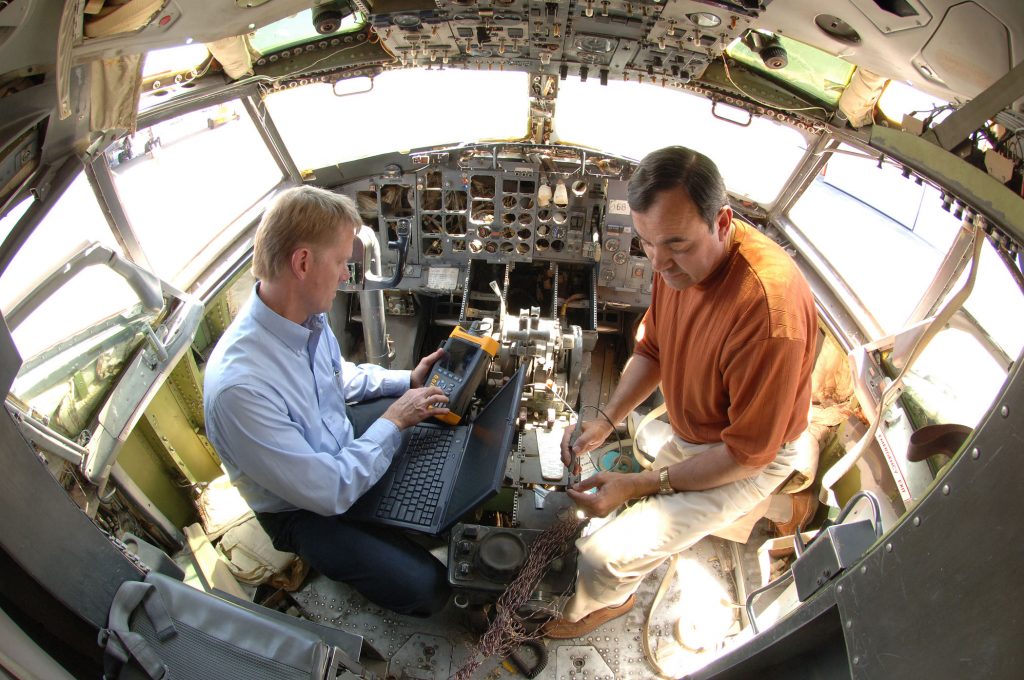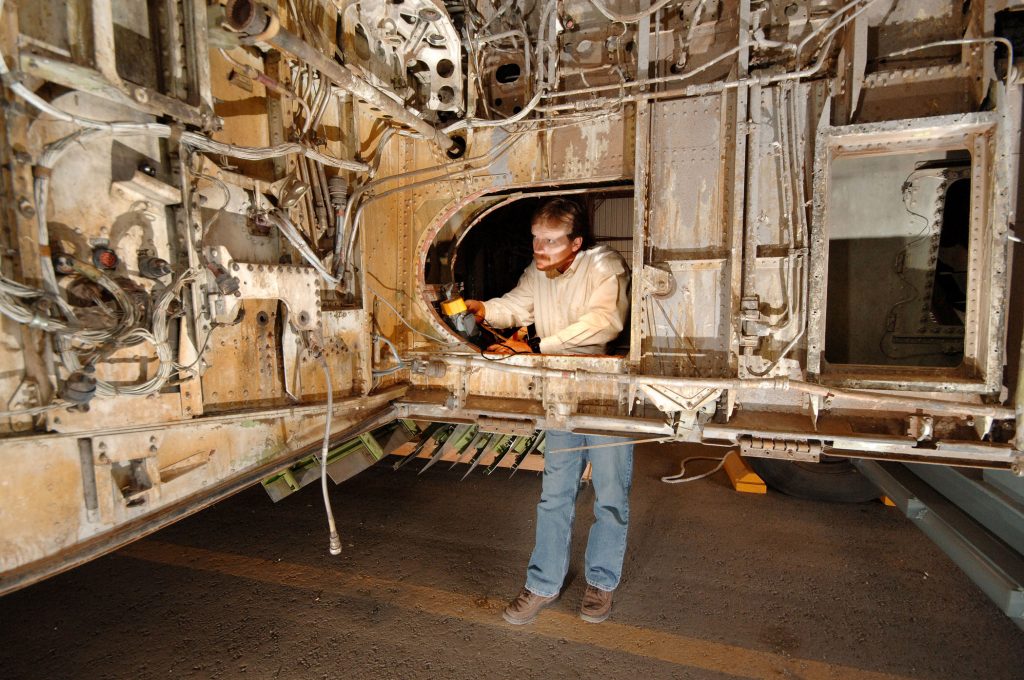
Download 300dpi JPEG image, “sparkfind-cockpit.jpg,” 412K (Media are welcome to download/publish this image with related news stories.)
ALBUQUERQUE, N.M. — A preemptive spark lasting for nanoseconds that helps find potentially dangerous short circuits hidden in the miles of wiring behind the panels of aging commercial airliners has been patented by Sandia National Laboratories.
The rapid technique may make it financially feasible for airlines to quickly diagnose and repair the hard-to-locate intermittent faults that have plagued the industry and cost millions of dollars in lost revenue due to aircraft downtime.
The product, called PASD (Pulsed Arrested Spark Discharge) is expected to be marketed by September by licensee Astronics Advanced Electronic Systems of Redmond, Wash., and combined with that company’s other patented test methods under the name ArcSafe.
Other possible uses eventually envisioned for PASD are as inexpensive tests for the wiring harnesses of passenger cars and new homes. Military tanks and the hard-to-reach wiring behind the steel bulkheads of submarines are also possible candidates.
The commercial product is about the size of a small suitcase. It can be plugged into aircraft-installed wire harnesses, 40 wires at a time, to check for the very small insulation breaks associated with intermittent faults.
Sandia is a National Nuclear Security Administration laboratory.

Download 300dpi JPEG image, “sparkfind-side.jpg,” 664K (Media are welcome to download/publish this image with related news stories.)
Detecting intermittent faults before they scuttle a plane
The challenge to engineers has been how to locate an intermittent wiring fault before — not after — it becomes a problem.
Intermittent electrical short circuits in aging commercial airliners range from the trivial to the deadly. They can make cabin lights blink, air conditioning falter, or even cause fatal crashes, as with flights SwissAir 111 or TWA 800.
PASD’s trick is to make the short circuit manifest before it normally would and to do so on the ground so that technicians can fix it. To achieve this, the Sandia method sends a nanosecond pulse of electricity, fiercely propelled by a high voltage, along airplane wiring bundles. The tiny pulse is powerfully driven so that it can jump gaps in slightly frayed insulation but has so little energy that it is harmless.
Energy like a trickle over a high waterfall
The process resembles sending a brief trickle of water over a high waterfall. The fluid will certainly fall a long ways very fast, but the tiny amount arriving at the bottom isn’t enough to do damage.
Because the voltage is higher than that normally used in airplanes, the electrical pulse will jump like a rabbit from the smallest wiring insulation fault (which to ordinary instrumentation seems undamaged) either to the bulkhead or to another nearby damaged wire. That spark — like static electricity leaping from hand to doorknob — in effect lights up the invisibly damaged spot like a tracer bullet at night lights up a target. The amount of time it takes for the current to return to its source is analyzed by the automated test-set to tell within inches how far the break is from the test entry point.
“Rather than reacting to a problem, these systems can find a fault before it manifests into a catastrophic event,” says Sandia team leader Larry Schneider. “Rather than ripping apart the fuselage for access to a faulty harness that may run the length of the plane, airline mechanics will be able to use this new tool to efficiently locate and repair the intermittent fault.”

Download 300dpi JPEG image, “sparkfind-side.jpg,” 664K (Media are welcome to download/publish this image with related news stories.)
Faults the size of a pinhole, or invisible as a slice from a razor
Sporadic short circuits occur where two exposed conductors, or a conductor and aircraft frame, make temporary contact during flight. Vibrations caused by turbulence may cause wires to touch, interrupting power to sensitive electronics and possibly damaging wires. These conditions are tricky to diagnose when the aircraft is stationary (on the ground) because the shorting wires often have shifted back to a non-shorted state. Sometimes these breaks can barely be seen by the naked eye because missing insulation may be the size of a pinhole, or nearly invisible like a fine cut from a razor blade. Traditional wire-test systems have great difficulty finding these faults.
To overcome myriad problems initially besetting the promising technique, the National Nuclear Security Administration and the U.S. Navy supported the research, followed by the Federal Aviation Administration, to the tune of about $2 million. It took two years for Astronics to adapt it to its suite of tools, which were developed over four years of research to locate wire breaches with the potential for electrical shorting.
Says Astronics team leader Mike Ballas, “We really value PASD technology. We licensed it, turned it into a practical portable test unit targeted for the aviation industry to find intermittent faults, and we believe it’s the best way now to do the job. It’s a nice complement to our patented technology.”
Says Robert Pappas, Federal Aviation Agency project manager for aging aircraft research and the first to recognize the value of Sandia’s original research proposal in 1998, “It would have been unfortunate if PASD had been developed and then remained stuck in a lab. Integration of the technique [with those of Astronics’ ArcSafe] is a real success story.”
There’ll be problems, just the same, in getting the method accepted, says Mike Walz, current FAA overseer of the project. For one thing, he says, “What PASD looks like is an electrostatic discharge [ESD] — something aircraft manufacturers work hard to keep out of their wiring system.”
One researcher responds with humor, “[In that respect,] PASD is a little like homeopathy: Uncontrolled ESD can kill you, but a little bit can help cure you.” In electronics, at least, the theory seems to work.
More technical information
Astronics welcomed the addition of PASD because of other problems involving the varying resistance of wires over long distances, called electrical impedance, particularly in the branched wiring systems prevalent in aircraft. This was a problem for earlier versions of ArcSafe, which used a DC current to detect breaks. Varying impedance meant it was difficult to accurately locate an intermittent fault, since electrical return signals were inconsistent, especially on complex wire geometries. Still, the DC method is most effective for identifying ordinary faults and Astronics retained it for quick fault screening.
Rider on a horse
To enhance its fault-locating ability, Astronics developed a method that allows the PASD pulse to ride upon the DC current like a rider on a horse. The DC current provides support for the high-voltage pulse, which then can be effective even a hundred feet from its starting point in accurately locating critical breaches in wire insulators, even those occurring on branched wire-harnesses. The distance to a fault is computable, regardless of changes in impedance produced by the wiring as it reacts to the PASD pulse at various voltage levels.
“Wiring insulation grown defective over time can cause malfunctions or even fires, but is devilishly hard to spot and even harder [once spotted,] to [exactly] locate,” says Schneider. “Other methods have faltered when confronted with the varying impedances of bundles of wires, or the difficulty of providing the exact location of the defect as wiring bundles branch into other bundles. This nondestructive, inexpensive method not only detects cracking or pinholes but also is able to pinpoint the defect’s precise location to facilitate wire replacement.”
The actual location of the defect may require checking out over several possible branches, since the same distance-to-short may exist along several paths, but the problem is minor compared with the alternative.
The hybridized system is an improvement because of its greater robustness on complex systems.
The technique probably would be best used to check those wiring subsystems that are known problem areas, says Larry. To check all the wiring in a plane might take several days.
Sandia pulsed powerPASD relies on a Sandia specialty called pulsed power, developed over decades of research. Usually the public thinks of this research — if it thinks of it at all — in terms of Sandia’s massive Z machine, which sends great bursts of electrical current down conduits as big around as a horse’s girth. But the PASD device in its experimental state was only the size of a small refrigerator.